It was a blazing hot summer’s day in central Queensland when Rachael Shardlow’s family – her older brother Sam, their parents, Ruth Macklin and Geoff Shardlow, and their dogs – decided to head for the water. But which water: lake, river, ocean? Ten-year-old Rachael pushed for the dam, at Lake Awoonga. Someone had told her there were crocodiles at Calliope River, and she was scared. But the lake was a wildlife sanctuary: no dogs allowed.
Rachael would not budge – so her family called her bluff, bundling into the car and driving off without her. They had only reached the end of the street before Rachael caved, calling them to come back and get her.
At the Calliope River rest area, a popular campsite around 14 miles upstream from where it meets the Pacific, Rachael was still too nervous to go swimming. When Sam and a friend got on a bodyboard in the shallows, she sandwiched herself between them, dangling her legs in the water.
Moments later, she started screaming. Sam, then 13, pulled his writhing sister out of the water and on to the riverbank, a huge gelatinous blob wrapped around her left leg. Rachael had been stung by a box jellyfish: the deadliest creature in the sea. Its venom stops the heart, killing adults in as little as five minutes.
The jellyfish was still latched on. “It was horrible. It looked like an alien, with all its tentacles wrapped around her,” Macklin tells me now. “I tried to pull them off with my fingers, but they were like harpoons.”
By grim providence, a camper nearby had lost his own brother to a box jellyfish and knew to run back to his campsite to get vinegar. With that, the tentacles retracted and the jelly could be wiped off “like snot”, Macklin says.
But Rachael’s vision had started to blur; she couldn’t breathe. “She said, ‘Am I going to die, Mum?’ Those were her last words before she passed out.” The man told them they had no time to lose: they would have to take Rachael to meet the ambulance, or else she would die on the riverbank.
Rachael’s heartbeat was weak. She was given antivenom and rushed to hospital in an induced coma. “She woke up when we got there – that was the worst part,” Macklin says. Her whole body was flailing up and down in agony.
Rachael spent the next two days in a coma. Tentacles had made contact with 30% of her body: injuries usually seen only in a morgue, marine toxinologist Jamie Seymour said at the time. Her leg resembled black, bloody tree bark, the skin shattered with hot red welts.

Her parents feared permanent brain damage. “But when she woke up, she was fine,” Macklin says. Rachael’s recovery, in defiance of medicine and marine biology, made headlines. “‘Miracle Child’ – that was all over,” Rachael, now 21, says from her home on Queensland’s central coast. “Everyone knows about boxes,” she adds. “They’re the bad ones. The worst.”
Rachael’s encounter was life or death, but even the sight of less harmful jellyfish can be enough to send most swimmers dashing out of the water. And they’re increasingly appearing on coastlines worldwide. Sudden, short-lived, concentrated “blooms” are causing severe disruption not only to days at the beach, but entire industries and ecosystems. Last year there were reports of mile-long blooms off the coast of south Devon, swarms of stinging lion’s mane jellyfish off the Isle of Lewis and the potentially lethal Portuguese man o’ war (not technically a jellyfish, but a relative: a siphonophore) washing up on beaches across southern England.
Already this summer, jellyfish have been reported in their hundreds in Suffolk, Essex, Kent and Devon. Two weeks ago, the Marchwood power station near Southampton was forced to shut down after its systems were blocked by jellyfish: a first in the site’s history.
Similar scenes are being reported all over the world, with jellyfish appearing to be flourishing in slowly warming seas. Are these weird creatures of the deep seeing an unprecedented population boom – or are these blooms just part of the natural cycles of the sea? And as a lockdown-battered Britain prepares to head for the beach this summer, is it safe to go back in the water?
Pretty much anywhere there’s sea, there are jellyfish. An estimated 150 million people are stung every year, including hundreds fatally, though the true numbers are likely higher. Since record-keeping began in Australia in the 1880s, 79 people are thought to have died from box jellyfish stings in those waters, and at least two from Irukandji, its tiny but similarly deadly relative, with venom that can cause brain haemorrhage. The most recent death was in March, of a teenage boy in western Queensland: the first fatality in 14 years.
The rate of Irukandji stings has been steadily increasing in southern Queensland, indicating that its territory is expanding with warming waters. There are signs that more minor irritants are posing problems, too. Non-lethal Indo-Pacific men o’ war, known as bluebottles, are a part of life in coastal Australia. But in 2019, the arrival of a massive armada saw 22,300 people in Queensland seek treatment for stings in five weeks, compared with 6,800 over the same period the previous year. In just one hour, thousands of people were stung – putting enormous pressure on responders and jeopardising the state’s £6.5bn tourism industry.
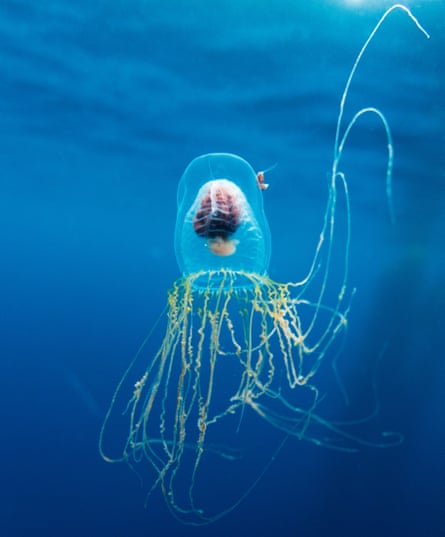
In Israel, recent summers have been marked by six weeks of jellyfish swarms, closing beaches and clogging power stations’ cooling systems. In Japan, giant Nomura’s jellyfish are causing havoc at fisheries. In Greece, stingers have terrorised tourists to such an extent that resort operators have threatened legal action against authorities for inaction.
From Tunisia, where fishers report catching more jellyfish than fish, to Denmark, where northern fjords and straits are said to be “like soup” in summer, to Mexico, where boats have been known to sink with the weight of their catch – it may seem as if jellyfish are taking over.
As an open-water swimmer, Lucy Hatfield, a 32-year-old nurse from Cornwall, is used to encountering jellyfish. “We used to play in the sea all summer when we were kids, and none of us would get stung,” she says. “Now, if I get to the end of the summer without being stung, it’s pretty unusual.”
Certain species are regular visitors to southern England and parts of south Wales through spring and summer, and sometimes in large numbers. These include the compass jelly, with V-shaped markings and long, thin stinging tentacles; the barrel or dustbin-lid jellyfish, up to one metre in diameter and solid but harmless; and the blue jelly, so called for the colour of its bell, which carries a mild sting. More unpleasant is the lion’s mane jellyfish, found in colder waters further north, with a brownish-red bell that can exceed two metres across and hair-like tentacles. It can dispense a painful sting – even when washed up dead on the beach.
After swimming the Channel in 2018, Hatfield set out the following year to repeat her triumph in the 21-mile stretch between the coasts of Northern Ireland and Scotland. Within hours of leaving Donaghadee, County Down, she found herself caught among hundreds of massive lion’s mane jellyfish. At first she was unfazed, dodging the ones she could and brushing past the ones she couldn’t. But after three hours of swimming, she had been stung more than 50 times: “It was like touching the same nettle over and over again.”
Her legs spasming, shaking from the cold and with at least another 10 hours’ swimming to Portpatrick, Hatfield admitted defeat. On board the support vessel, the pain only worsened as her body warmed up. “By the time we got back to the harbour, I could hardly walk,” she says.

When she got to hospital back in Donaghadee, Hatfield’s heart rate was 147bpm: around double the normal pulse for an adult. She was given intravenous fluids and morphine, kept in hospital for the rest of that day, and spent the next day bathing in calamine lotion. But she hasn’t let the experience put her off: she is attempting the crossing again next month. Increasingly, she says, the risk of a sting is something open-water swimmers know to take in their stride. Most in Cornwall have adapted: “There are too many of them down here to avoid.”
As ever, the changing climate presents further uncertainty. The breakdown of the Gulf Stream, coupled with warming seas, could bring to UK shores unfamiliar jellyfish, such as those found in the open ocean or the Mediterranean. The mauve stinger – a nomadic species with an intensely painful sting – is an infrequent but impactful visitor, wiping out entire farms of salmon in Northern Ireland in 2007 and in Ireland in 2013. A few sightings of the Portuguese man o’ war were reported on beaches in Wales, Bridport in Dorset and Brighton late last year.
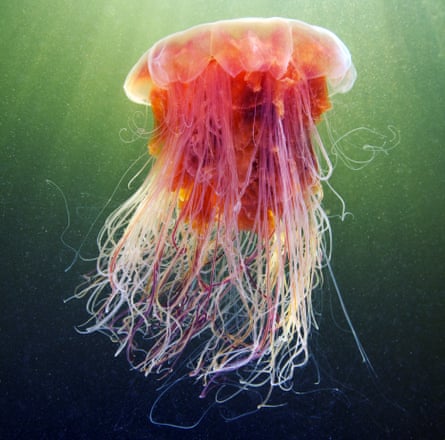
In the Marine Conservation Society’s most recent annual survey of jellyfish in UK waters, in 2014, the mauve stinger and man o’ war together accounted for fewer than 10% of records. But in the Med, particularly at popular holiday destinations in Greece, Spain and Malta, these jellyfish are already causing havoc. Sharon Balzan, a 49-year-old teacher’s aide, has lived in Malta all her life and has spent nearly every summer swimming with many of the same people, in almost exactly the same spot: right by Gillieru hotel’s bar, in a sheltered corner of the harbour.
But it is only in the last few years that she has started carrying a bottle of vinegar and some bicarbonate of soda in her bag, to mix into a paste and apply to stings if she has to. None of the species Balzan and her friends typically see are lethal – but any they encounter go the same way: caught in a net and dumped onshore in a nearby bin. “If we see one, we search for more,” Balzan says.
Every now and then, a big, blousy fried-egg jellyfish will breeze by, known locally as qassata for its resemblance to Malta’s traditional ricotta-filled pastry. But since the mid-1980s, the most abundant in Maltese waters have been mauve stingers – and they are significantly more venomous.
“It’s like an electric shock in the sea,” Balzan says. When swimming, she has learned to be proactive about clearing the water around her, so that if she is stung, it is on her hands, not her face or throat. Then she rubs out as much venom as she can in saltwater, before applying her vinegar-bicarbonate paste.
She guesses that she is stung about once a summer. “It depends how lucky or unlucky you are,” she says. She remembers a friend’s daughter, about 14 at the time, emerging from the water screaming and writhing in agony. “We couldn’t make sense of why,” she says. Then they noticed the girl’s long hair lashing her neck, back and stomach. “I told her to stop: the jellyfish was in her hair.”

The girl’s body was “massacred”, Balzan says matter-of-factly. But by the next summer, she was back in the sea – albeit with her hair cut short. “We got used to it,” Balzan shrugs. The Maltese have learned to live with jellyfish as an inevitable peril of island life. The popular national Spot the Jellyfish campaign, collating sightings from the public, has built a record of mauve stinger blooms dating back to 2010. While the frequency of blooms has been roughly steady, the numbers of jellyfish and geographical spread have increased.
In 2018, massive blooms made up of thousands of jellyfish, densely packed, erupted in bays all along Malta’s 250km coastline, creating a plum-coloured, gelatinous mass spread over hundreds of square metres. “It is intense – they appear everywhere,” says Alan Deidun, a professor at Malta University and head of a local awareness scheme. Deidun’s name is synonymous with jellyfish in Malta – a reflection of his volunteer work in the community to prevent and treat stings (Balzan learned from him to use the vinegar-bicarbonate solution).
He identifies four factors in the apparent “explosion” of jellyfish around the world. Warming temperatures seem to be prolonging blooms, speeding up some species’ reproduction cycles and enlarging others’ territories. Changes in water quality play a part: jellyfish can thrive in low-oxygen, polluted environments. And maritime structures such as jetties and oil rigs have given them more surfaces to colonise with their young.
But most influential is the impact of overfishing, Deidun says. With around 90% of global fish stocks exhausted, overexploited or depleted, according to the UN, there is less competition for the zooplankton both fish and young jellies eat, while a decline in predators (notably turtles) has increased their survival rate. The increase is not linear: some species are less adaptable, and numbers depend on ocean conditions early in the year. “Each jellyfish season is different,” Deidun says, which complicates attempts to predict it.

With the mauve stingers slow to reproduce in spring this year, he is predicting a big bloom any minute now, in early July – “right in the middle of bathing season”.
Pre-Covid, the presence of jellyfish was the “million-dollar question” for Malta’s tourism industry, Deidun says. Ten years ago, it pushed for solutions, after limited success with trials of protective nets: “Now they’ve sort of given up.” They are coming to accept his advice that there is little that can be done beyond educating visitors. “You have to learn to live with it,” he says. The island is small enough that if the wind is blowing the jellies on to one beach, it is easy to get to another that is protected, and the blooms do not stick around for long. “There are places in the Mediterranean where it is much worse,” Deidun says.
To the east, a one-way stream of invasive species through the Suez canal from the Red Sea has been causing severe disruption in Israel, Egypt and Turkey. The “plague” of nomad jellyfish since the canal was expanded in 2015 has been put forward as a case against widening it further. Meanwhile, to the west, Portuguese men o’ war are disrupting tourism along the southern coast of Spain. In 2018, a swarm shut down nearly 100 miles of beach around Alicante. Some authorities now contract fishers to catch those that are swept in from the Atlantic by westerly winds. “They collect them by the bucketful in spring,” Deidun says, in disbelief. “And those can actually kill you.”
In normal, non-pandemic times, tourism to Spain’s Mediterranean coast is worth around £102bn annually, contributing 12% of the country’s total GDP. A 2016 study found that 117,000 people were stung by jellyfish on those beaches from 2008 to 2012, accounting for 60% of total incidents reported to lifeguards; updated findings found this increased to 63% between 2013 and 2018.
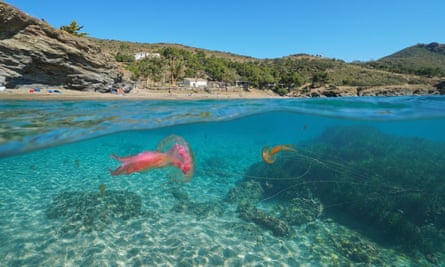
In Gibraltar, one of only a few viable holiday destinations for Brits (it appears on the UK government’s green list at the time of writing, as is Malta), there have already been reports of unexpected jelly activity. Lewis Stagnetto, a marine biologist who grew up in Gibraltar and works for local marine education charity the Nautilus Project, says there was a bloom of mauve stingers in Rosia Bay in April, with more expected as temperatures rise. There have also been more than 20 sightings of stinging cauliflower jellyfish, a species rarely seen and little understood: “Historically, if we’ve seen just one, it’s been a big deal.”
Stagnetto remembers a couple of years ago, snorkelling through a mass of mauve stingers inches thick. To breathe, he had to duck-dive beneath the bloom and blow bubbles, forcing a hole in the purple blanket in which to surface. “It was one of the most difficult snorkels I’d ever had to do,” he says. “It was thick like ice all over the surface.”
Nets have been installed around several popular beaches, offering some (but not total) protection, while purple flags are flown to warn of recent sightings. Some swimmers have taken to wearing lightweight, protective “stinger suits”, Stagnetto says. Other coastal communities around the world may soon be forced to do the same. “I think Gibraltar is a good microcosm for what’s happening globally,” Stagnetto adds.
What is it about jellyfish that has always captured our imagination? Their sheer strangeness seems to lead us to infer malevolent intent, despite the fact that they are made up of as much as 98% water. A type of plankton, they have no brains, hearts or bones. Their primary sensory organs are their tentacles.
They sting on contact because their venom immobilises prey – small ocean creatures such as plankton, fish eggs, sometimes other jellyfish – allowing them to be transported to their mouths in the centre of their bodies. Jellyfish have been observed performing mating rituals not considered possible of such a simple organism. Some, such as the mauve stinger, are bioluminescent, meaning they glow in the dark. One species, Turritopsis dohrnii, is able to regenerate itself when damaged or injured, and is considered theoretically immortal. Jellyfish in the oceans predate humans and even dinosaurs by many millions of years.
“Jellyfish are here to stay,” Deidun says. For all of human history, the dominant presence in the marine ecosystem has been fish. “There is a danger that if the number of jellyfish in the Mediterranean rises beyond a certain point, it will flip from a fish-dominated to a jellyfish-dominated sea,” he says.
This transition is already under way. Earlier this month a WWF report warned that “‘jellyfication’ of the Mediterranean is becoming a reality”. The repercussions could range from the decimation of lucrative tourism and fishing industries, to food insecurity for coastal communities. Deidun predicts that the chaos they are causing in Israel will reach Malta within the next five to 10 years. The UK, meanwhile, might glimpse its future in Malta’s abundance of mauve stingers. “We are all heading in the same direction: overfished, warmer waters – and more jellyfish.”
New blooms in some popular tourist destinations, however, do not necessarily mean there has been a sustained increase in baseline numbers globally. In 2013, Kylie Pitt, head of Griffith University’s Sea Jellies Research Laboratory in Queensland, and a crew of international colleagues, assessed the evidence and found it lacking. Some areas are seeing more blooms, Pitt says now – but “it’s certainly not true everywhere, and not of all species”. Those in decline are often overlooked, she says. Her analysis of long-term datasets indicated that jellyfish numbers have always oscillated in 20-year cycles. It suggests the current boom may be not a harbinger of our coming climate doom, but in line with historic trends. “It may be that we are in another rising phase, and in a few years’ time we will be in a declining one,” Pitt says.
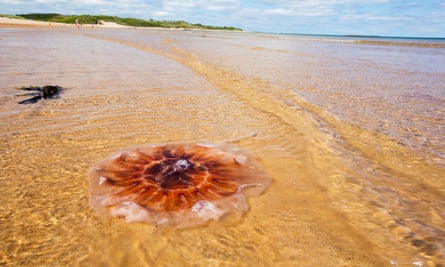
To some extent, she adds, the widespread perception that jellyfish are on the rise may just reflect the fact that there are more people in the water to see them. The exponential growth in tourism, watersports and other recreational coastal activity over the past 20 years has packed beaches with amateur jellyfish spotters, able to report back via social media. In July 2019, viral photographs showing swimmers alongside enormous barrel jellyfish off the coast of Cornwall presented them as extraordinary, when in fact they are one of the most common visitors to UK shores.
But even if the coming jelly-pocalypse has been overstated, the damage already being done by blooms, and the challenge of reversing whole ecosystem changes, means that jellyfish are a problem we must prepare to face. The WWF report concludes that “the jellyfish are here, and we need to adapt”.
Could adapting involve swapping cod and chips for something a bit chewier? When Jamileh Javidpour, an assistant professor of biology at the University of Southern Denmark, read a warning from a fisheries scientist that if overfishing continued, we’d be down to eating jellyfish, she asked herself: “Why not?”
That was the seed for GoJelly: an ambitious project to explore ways of using jellyfish as feed for aquaculture and agriculture, organic fertiliser and even recipes to appeal to western palates. Though jellyfish are established in east Asian cuisine, the “watery body with a lot of sauce” and “leather-type bell”, as Javidpour politely describes it, is not to all tastes. GoJelly released its European Jellyfish Cookbook in March in the hopes of broadening their appeal, including recipes for jellyfish with yoghurt and puntarelle chicory. (German researchers are working on jellyfish chips.)
More ambitious is GoJelly’s plan to use jellyfish mucus to trap plastic particles, preventing them from entering the sea – thereby tackling two problems of destructive “marine debris” at once. Prototypes of these so-called “biofilters” tested in the Mediterranean have shown close to 100% efficacy using only a small amount of slime. The global abundance of jellyfish means it could make a significant impact on the problem of nanoplastics, says Javidpour, principal coordinator on the project. “It’s a very simple system that works – the next step is to scale it up, and find investors.”
The first step for Britons, in adapting to our jellyfish future, may be to better understand the risk. In May last year, Libby Bligh and her friend Agnes were swimming at Whiteness Beach in the Scottish Highlands when they were visited by a seal. Distracted, and standing in waist-deep water, Bligh, 51, stuck her hand into what she thought was a massive seaweed bush.
Then she felt the pain – like boiling water being poured over her hand. The “bush” was in fact a lion’s mane jellyfish, about a metre across. “I’d never seen a jellyfish that size. It was like a hula hoop,” Bligh says. With the pain intense but seemingly confined to her hand, she decided to drive herself to the nearest A&E.
But within 10 minutes, the stinging sensation started to spread up her arm and into her chest. “At that point I knew what was going to happen,” Bligh says. “I said to Agnes: ‘I’m going into anaphylactic shock; I’m going to pull over.’”
It had been 15 years since Bligh’s allergy to crustaceans had triggered an anaphylactic reaction; she had no idea that a jellyfish would trigger it, too. She ended up spending 48 hours in hospital. Doctors told her she should never go back in the sea again.
Since then, Bligh has only ever swum in freshwater lochs, not even daring a paddle anywhere else. “With jellyfish increasing in size and numbers, they’ve won the battle of the seas for me,” she says. Her encounter has increased awareness among other swimmers in the area. A stranger once revealed she kept Bligh’s photo up on the fridge, as a reminder to her son to take care while paddleboarding at the same beach.
As for what to do if you are stung, Bligh admits her first thought was “that episode of Friends”. Experts advise against it – urine can sometimes even aggravate the jellyfish to release more venom – but Chandler peeing on Monica is still many Britons’ reference point in an emergency: testament to the need for greater education about the different species of jellyfish in UK waters and what to do in the event of a sting (the NHS advises rinsing in saltwater, removing any spines from the skin and seeking help from a lifeguard).
If jellyfish do continue to swarm UK shores, being able to tell a benign barrel from a stinging compass will be important. Perhaps we should look to Australia, where beaches at risk are often protected with nets, patrolled by experienced lifeguards and even supplied with bottles of vinegar. Visitors are generally sanguine about the risks they take.
“I wouldn’t say it’s a rite of passage to be stung by a jellyfish, but it’s certainly very common,” jellyfish researcher Kylie Pitt says. “We don’t like it – but we live with it.”

Sometimes people will ask Rachael Shardlow about the scars on the back of her knee, or she’ll get talking with swimmers about their brushes with jellies. Recently, she met a woman who had just been hit in the face by a bluebottle, whose partner had been stung by an Irukandji. It wasn’t a contest – but Shardlow won. “I just said I had been stung by a box jellyfish and had three metres of tentacle contact,” she says. “Their reactions were priceless. They couldn’t believe it.”
Now studying photography, she still lives with her family near the site where she was stung. And when she heads to the beach, does she go in the water? “Oh, I still swim,” she says, casually.
Her mother laughs and adds, pointedly: “I do not.”
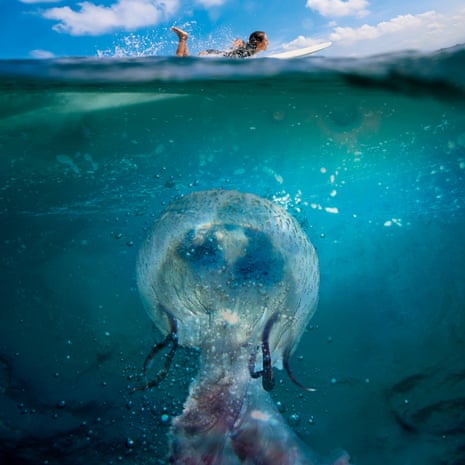
Comments (…)
Sign in or create your Guardian account to join the discussion